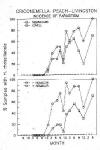|
The terms are not synonymous.
- Regulation implies a buffering impact on population change.
- Suppression indicates population reduction.
Both are legitimate goals of biological control.
Regulation and suppression by biological antagonists may be expected to
exhibit the known phenomena of population interaction,
including spatial and temporal density-dependence,
especially if the mechanism involved is exploitation or
antibiosis.
- Density-dependent regulation implies that the level of parasitism or predation that is occurring in the population
depends on the density of the population. In the case of fungal infection of nematodes, the probability that
infection will spread to healthy individuals depends on the numbers of individuals present. Similarly for predation.
- Hence, the proportion of the population that is parasitized or killed by predators will increase as the population
increases. There may have to be many nematodes present for the proportional mortality to be high.
- The residual
population may still be above damaging levels.
Spatial density-dependence recognizes that the populations
of antagonists are seldom uniformly distributed.
- The percent parasitism or predation may be high in high-density
aggregates and low in low-density aggregates.
- This raises the issue of scale in studying ecological systems, and constitutes the basis of Murdoch's descriptions of the possibility of "local extinction and global stability".
Temporal density-dependence recognizes that population
densities change through time.
- Consequently, the
proportional antagonism may be higher seasonally when host
or prey populations are higher.
- The concepts also allow for
a time lag in the relationship between the host and
antagonist.
Consider the notion of population regulation in biologically-
buffered soils as a community phenomenon rather than the
result of interaction of two populations.
Hence the need to
develop multiple-decrement lifetables, as in studies of
human ecology and as suggested in entomology (Carey), in
understanding and assessing the
suppressiveness of soil. |
